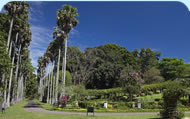Nowhere is Sri Lanka’s rich diversity more evident than in Kandy. The colonial rulers called it Kandy for Kanda in Sinhala, meaning a hill. The capital of the Kandyan kingdom in the 16th century and the seat of much of Sri Lanka’s culture this royal city was occupied by the British when the last Kandyan king Sri Vickrama Rajasinghe was captured by them in 1815.
Nestling amidst low hills, and looped by Sri lanka’s largest river the Mahaweli, Kandy is still the home of the arts and crafts, music, dance and song which flourished during the last kings reign.
This beautiful city, with its hills and valleys, rivers, lakes and cascading waterfalls around the hills, has its fair share of hallowed and living shrines, of the Buddhists, Hindus, Christians and the Muslims in the city and around. But to the Buddhists Kandy is a sacred city.
Situated 129km(81miles) from Colombo, it is geographically situated in the centre of the hill country, Kandy is the capital city of the area.
Some of the main attractions in and around Kandy are, The Dalada Maligawa built in the 16th century AD, Esala Perahera, Malwatta Asgiriya monasteries, Gadaladeniya, Lankatilaka and Embekke temples, Dodanwala devale and Suriyagoda vihare, Hindagala temple, Gangarama and Degaldoruwa temples, Galmadauwa vihara, Mediwela vihara, Victoria dam and the many scenic drives and walks of Kandy.
Festival of the August moon:
As the August moon begins to wax, the hill cradled city of Kandy will prepare for a splendid procession. For ten days, as the old cannon booms after dusk, the ‘Perahera’, the event Kandy lives for each year, will take to the streets, growing longer each night until on the final night the pageantry of the past shatters the present. The whips crack like pistol shots, the torches gild the pallid moonlight, drums roll like thunder down the narrow streets, the oboes wail, the braying conchs echo from the hills, the pious cries of ‘sadu’ lift thanksgiving to the sky, the dancers leap and whirl in flashing crimson, white and silver, the stately chiefs strut by rank upon rank by elephants loom up and dwindle, and the glitter of the sacred casket fades as the mile long magnificence passes.
Sri Lanka Tourist board and Hotel Corporation guesthouses and other international class hotels offer a range of facilities. Travelers on a lower budget can find accommodation with private homeowners offering very basic facilities. Camping facilities are also available for outdoor enthusiasts.
Website tracking
Thursday, July 31, 2008
Peradeniya Gardens

Peradeniya botanical gardens is considered as one of the finest of it's kind in Asia. It is the largest of the three botanical gardens in the island. Situated in Peradeniya, just outside of Kandy, it has many different varieties of flora thanks to the Mediterranean climate of the area. All tourist visiting the hill country never forgets to make a stop at the gardens.
The 60 hectare garden is bounded on three sides by a loop in the Mahaweli River, the longest river in the country. The original park was created way back in 1371 as a queens pleasure garden. Later it was developed by King Kirti Sri Rajasinghe (1747-1778), as a place where royal visitors could be entertained. It was converted to a Botanical garden by the British in 1821, six years after the fall of Kandy. The garden became a testing ground for crop cultivation. Tea, Rubber, Coffee, Nutmeg and many more were first tested here before they were used for mass cultivation.
There are ten thousand plants and trees, including 4000 labeled species. A signboard at the entrance features a map with numbered circuits from 1-30, and corresponding markers are placed strategically along the route. There are extensive well-kept lawns, pavilions, an Octagon Conservatory, fernery, banks of Burmese, Chinese & Japanese bamboos & numerous flower borders with cannas, hibiscus, chrysanthemums, croton & colourful bougainvillaea. The Spice garden and the Orchid house has an outstanding collection of species.
At the center of the gardens there is an artificial lake with a variety of water plants including giant water lilies and papyrus reeds. Next to the lake a white domed rotunda commemorates George Gardener, who was the superintendent of the gardens during 1844-1849. He collected thousands of specimens during his four years of explorations in Brazil & was responsible for importing rubber as well as cinchona. Both of these imports have been blessings to the island; rubber becoming a prime export & bark of cinchona tree producing anti malaria drug quinine.
Subscribe to:
Posts (Atom)